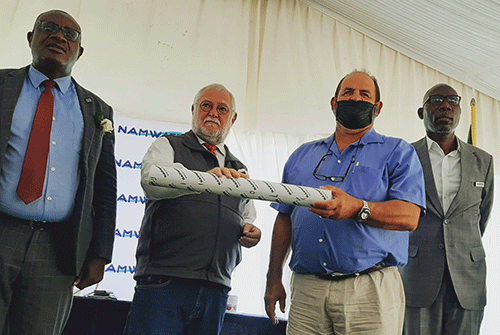The Minister of Agriculture, Water and Land Reform Calle Schlettwein said the provision of clean drinking water for both humans and livestock in rural and urban areas remains central to the government’s agenda.
The minister said development is not possible without water, hence water infrastructure should be essential for any developmental projects of a country.
Schlettwein said this during the launch of Ohangwena Wellfield project on Saturday at Omulondo village in Oshikunde constituency, which is expected to accelerate the provision of water to constituencies of Epembe, Oshikunde and others in the Ohangwena region, whose residents continue to rely on water from wells, rainwater and boreholes, which is not fit for human consumption.
The Ohangwena II Wellfield project will be carried out by Element Consulting Engineers PTY Ltd and is expected to be executed within 41 months. The project is expected to contribute towards reliable access to safe drinking water once completed.
Schlettwein indicated that the Ohangwena region would benefit from government water supply projects, given the vast potential that the region has if water resources are fully exploited.
He said the government is aware Ohangwena Aquifer II is a largely unexploited resource with significant potential to supply potable water to the Ohangwena and Oshikoto regions. The aquifer is believed to span roughly 70km by 40km on the Namibian side of the border and is 250m-350m deep.
Government, through NamWater, initiated the Ohangwena Wellfield project, to provide water supply infrastructure, to improve and increase the bulk water supply capacity of Omafo-Eenhana and Omakango-Onambutu-Eenhana schemes to meet the water demand.
Residents of the Oshikunde constituency have in the past complained about the lack of clean drinking water, saying government has failed to provide their most basic need.
They walk long distances to fetch drinking water from the boreholes and wells, which they still have to boil to reduce the risk of becoming ill.
Oshikunde constituency councillor Lonia Kaishungu said with a large population of over 20 000 inhabitants in 81 villages, access to potable water remains the biggest challenge for them.
Kaishungu said the lack of clean water is the main and growing challenge in her constituency because many villages don’t have taps.
“Some villages have boreholes but water is not suitable for human consumption, because it is salty,” she explained. She further said these residents, therefore, prefer to fetch water from the wells and that some villages do not even have wells.
The councillor added water is not the only issue in her constituency. The lack of proper roads and network connection, which makes contacting emergency services difficult, is also a concern. NamWater board chairperson Thaddeus Mashawu said they have been supplying water to the western parts of Ohangwena region, including Eenhana from Oshakati via Omafo and that water originates approximately 300km away at the Calueque Dam in southwest Angola.
Mashawu said the discovery of the Ohangwena Aquifer II came at the right time to ensure water supply reaches Eenhana, as communities often suffer from dry taps.
While launching the Oshakati purification plant extension on Friday, Schlettwein said government’s plans include the implementation of several water infrastructure projects as components of a compressive bulk water infrastructure development programme for an integrated water supply system countrywide.
“In the northern region, it entails the upgrade and replacement of the water supply system linked to Kunene River as a source, the Oshakati purification plant and the canal, and the pipeline system distributing water to the east, west and south of Ruacana,” he said.
He stressed that the government realised that the canal infrastructure, the stretch from Omahenene border post to Oshakati, needed to be reconstructed to restore it to its original design so that it can continue to serve the people for many years to come. “The construction of this canal is very crucial as it will ensure that the four treatment plants and especially the Oshakati plant have enough water to purify. Nevertheless, the Oshakati Purification plant capacity to purify enough water for the people cannot any longer satisfy demand due to population growth and other factors, hence the need to refurbish and enlarge it,” the minister said.
– fhamalwa@nepc.com.na


